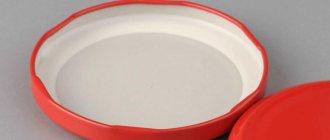Many people do not like to throw away potentially useful things, and sometimes a huge amount of junk accumulates in their apartments in reserve and just in case. A non-exception, and a very cumbersome one at that, are empty glass jars.
Where to store them and how best to do it is a very pressing question. Together with uneaten preparations, they take up a lot of space, spoil the interior and often suffer themselves, becoming covered with cracks and chips.
Sign: People believe that storing empty jars means poverty. After all, the container takes up space that could be occupied by filled dishes.
How to store empty cans in an apartment: practical tips, signs about empty cans
Many people do not like to throw away potentially useful things, and sometimes a huge amount of junk accumulates in their apartments in reserve and just in case. A non-exception, and a very cumbersome one at that, are empty glass jars.
Where to store them and how best to do it is a very pressing question. Together with uneaten preparations, they take up a lot of space, spoil the interior and often suffer themselves, becoming covered with cracks and chips.
Sign People believe that storing empty jars means poverty. After all, the container takes up space that could be occupied by filled dishes.
General layout plan
Empty cans at the dacha, in a private house, and even more so in a cottage, do not pose a particular problem - they can be easily removed to any non-residential premises. Many generally store them outside, fortunately glass containers tolerate this.
With an apartment, things are more specific, especially if it is small. Here you have to get smart and look for non-standard solutions.
The most obvious options for an apartment are a loggia, mezzanine or storage room, if available.
As a general rule, it makes sense to remove jars that are not needed until the next season further away or higher. It is better to keep the same dishes and preparations that will be needed in the near future away from the aisle, but so that they can be easily approached.
Glue the labels
No matter where you store these glass items, make sure you know what goes where and when the expiration date is.
Buy stickers from any office supply store and attach them to the front of the jars. You can write the names by hand or print them out. If you don’t want to glue, you can make cardboard labels yourself and hang them from the neck using ribbon or twine. How do you like these kitchen accessories ?
Identical jars with inscriptions
Methods for storing cans and preparations
The most standard option is shelving. Both wooden and cheaper plastic ones. And the best thing is collapsible metal ones that can be adjusted and fixed on the wall. The only condition: they must withstand both empty dishes and with preparations.
Where to place the rack? If the pantry allows, go there. If you don't have one, Miss Clean magazine recommends placing shelving in blind corners and along walls so that they are out of the way and easy to access.
A less convenient location is the mezzanine. They are also suitable for empty glass containers, and reinforced ones are also suitable for full ones. But they are quite difficult to reach places.
The optimal place is free spaces and so-called “dead zones” throughout the apartment. This could be an unoccupied space in the kitchen, a niche/drawer under the bed or between cabinets. Away from the aisle so as not to accidentally touch it. If there are concerns about aesthetics, then the site mschistota.ru advises building small drawers or shelves that are suitable in each individual case.
For temporary maintenance, the “on top of each other” option is suitable. It is very simple and economical - again you need a blind corner and cling film:
- Sort containers by size.
- Wrap the film to each other, six pieces at a time, if we are talking about three-liter jars, wrapping one jar, and then, without cutting the film, the next one and so on.
- Then build a stable, low structure next to the wall.
- To be sure, you can wrap the entire “pyramid” with film.
In general, storing empty glass jars is definitely not a troublesome task, especially if the housewife clearly understands how much of such containers she will need and gets rid of the excess in time.
Candy jars
Let's start with what gives us pleasure. The confectionery products on display fascinate both children and adults. You will ask why? Because the owners of such stores know how to advantageously present multi-colored bulk sweets to the consumer.
Create the same effect in your pantry by using conveniently shaped containers like the ones in this photo that have a wide opening that allows you to easily reach with your hand or spoon to get what you want.
Don't let the name "candy jar" fool you. You can put not only sweets there, but also grains, dry legumes, etc.
Candy jar with old lid
This retro style bulk food container with a mint green lid costs $28. Thanks to it, your stylish kitchen interior will acquire some zest.
Other lid options, such as stainless steel or metal, will make the image of this jar even more elegant. Tip: If maximizing space is your top priority, place the most economically shaped items at the edge.
The best options for storing cans and preparations
Glass jars are a potentially useful item for most housewives. But those same ladies, as a rule, accumulate an incredible amount of different rubbish. Therefore, it is important to respect the boundaries of what is reasonable and come to an optimal compromise.
So, if empty jars will probably still be useful, let’s decide on a convenient storage method. The most suitable places for placement are a balcony, loggia or storage room. In this case, it is recommended to make wooden shelves taking into account the height of the cans. Those. it will be different for different volumes. Therefore, the shelves should be at different distances from each other.
Key points to pay attention to:
- An important condition is the ability to withstand heavy weight. This must be taken into account if long-term storage of packaged products is planned. It is advisable to choose shelves either from durable wood or from not too thin metal. These will function without problems for a very long time.
- If there is no balcony or pantry, you can place shelves in blind areas of the apartment or along the walls. The width of the protruding parts should not interfere with the movement of family members and pets.
- A slightly less convenient option is mezzanines. In modern homes they are becoming rare, so if necessary, you can make them yourself. It is only important to choose durable shelves and reliable screws or other fastening options. And the external doors can be decorated in the style of the interior.
The latter option will be especially convenient for families with small children and those living in apartments with a fairly modest area. In this case, it is recommended to provide lighting. You will have to act especially carefully when trying to distinguish a three-liter jar of cucumbers from at least a three-liter jar of apple juice. It was not enough to fall off a stepladder or stool during this process.
Tip: Use battery-powered, self-contained light sources that turn on when the door is opened. These cost pennies on AliExpress or Juma.
Even for particularly long-term storage, the “on top of each other” option will work:
- sort the containers by volume;
- then alternately wrap 6 or 9 pieces of cling film to each other, without cutting off the transparent fabric;
- arrange the resulting blocks into a tower-like structure that is not too high;
- For greater reliability, wrap the assembled pyramid with tape.
Installation of an insulated closet on an open balcony
The contents of the cans are fruits and vegetables placed in a liquid substance of brines and syrups of various compositions. It is the liquid component of preservation that is susceptible to freezing. This may cause the product to spoil and the glass shell of the jar to break. To preserve the workpieces in winter, it is necessary that the insulated box can maintain a positive temperature inside. To learn how to make a wardrobe on the balcony, watch this video:
The design of the insulated box for workpieces on the loggia is based on the principle of the structure of a thermos. Thermal insulation is placed in the gap between the built-in container and the cabinet body.
You must first install the cabinet on the balcony so that it does not block the light opening and is subject to minimal wind blowing. If the cabinet body is made of chipboard, then care must be taken to protect it from exposure to precipitation. Usually the box is covered with several layers of moisture-resistant paint.
Foam plastic, mineral wool, polyurethane foam or other insulation is glued to the inner surface of the walls between the shelves. The thickness of the thermal insulation must be at least 30 mm. The top, bottom and door inside the box are also insulated. The inner surface of the insulation is covered with fiberboard sheets, thin plywood or plastic. Instructions for installing a cabinet on a balcony:
In harsh climates, there is a high risk of “losing” workpieces even in an insulated cabinet on the balcony. Severe frost will not stop any insulation of the storage facility. Some sources of information recommend installing electric heating with incandescent lamps or other homemade devices in insulated cabinets.
However, this circumstance significantly increases the risk of a fire due to a short circuit in the homemade electric heating system; in this regard, it is more advisable to look for another place to store winter supplies.
Apartment accommodation options
If the area of the apartment allows you to fence off a small area, it is better to do just that. Externally, the area is very easy to disguise with plastic panels - this is much more hygienic than curtains, and set up shelves inside. Another option is a mirror on one of the walls, this has double the benefit, and the room visually expands.
If you have a balcony, it makes sense to insulate it. In winter, conditions will be ideal for storing blanks, and later empty cans. If there is no time or opportunity to do additional finishing and construction of shelves, it is convenient to store jars in bags. To do this, you need to carefully and tightly fold the container and tie the bag tightly. Then carefully assemble into a kind of pyramid and cover with a nice blanket.
Finally, beds with a lifting mechanism and a spacious drawer below are extremely popular now - this is also a great place for cans. Empty cans go to the far end, tasty supplies are closer to the edge, where it’s more convenient to get them.
In general, there can be a lot of accommodation options. If you are prone to forgetfulness, you can make separate notes in a special notebook. And if suddenly difficulties arise in the future, at any moment you can refresh your memories and immediately find the loss.
Master Class
each of us is a Master
40 ideas for using glass jars
Good afternoon, dear community visitors! Last year I posted a collection of “100 Button Ideas” and “100 Ideas for Valentine’s Day.” Since they were quite popular, I decided to continue the series of collections. It was not possible to collect 100 original ideas from cans, since this is a less universal item compared to buttons, but I hope that among the 40 options you will see something new for yourself.
The first idea for those who love to travel and collect collections of small souvenirs and memorabilia from different parts of the world. To ensure that all these valuables (pocket calendars, coins, pebbles, keychains, etc.) do not end up as a pile of incomprehensible garbage on the shelf, place items from different trips in separate jars. At the same time, you can create an original composition every time!
Using the same principle, you can collect small herbariums
Or create decorative compositions to decorate the interior.
Cans of various shapes can also be used to make original photo frames.
Or a decorative lamp.
Jars are perfect for children's creativity.
Aquarium for paper fish
Or even for real fish!
And another original idea - a jar with lottery tickets! Can be used for summer children's activities. This presentation option will certainly encourage children to do the work.
Let's consider options for using glass jars to create candlesticks, decorative lamps and oil lamps. In addition to single candlesticks, you can create entire intricate compositions or even make a chandelier.
With the help of such lamps you can decorate a garden gazebo or an open terrace.
Here is another option using a hanging system.
Marine theme. The jars are decorated with fabric.
Candlesticks can be decorated with live plants.
These candlesticks are equipped with handles. They are easy to move from place to place, or hang. The highlight of this option is the use of sand filler.
An interesting effect can be achieved by opening the cans with translucent paint, which gives a visual distortion of light.
Here is an example of creating a composition from cans of various sizes and shapes. A lot of burning candles captivate the eye, don’t they?
Glass jars can also be used to create original oil lamps.
Here is an option on how you can make your own candles using glass containers as a base.
We present to your attention ideas for using glass jars to create original vases. An interesting combination of the bright color of the bouquets with the muted natural color of the decor of the vases. Texture plays an important role.
The antipode to the previous examples is delicate romantic vases decorated with fabric.
A play of shapes and sizes – a composition of various glass containers, decorated with a matte layer of paint.
Here is an example of using pencils – bright and juicy!
Small plants need small vases! Original hanging version.
Knitting is used to decorate jars. Tender and romantic! You can use these containers for different purposes at your discretion.
And now – organizers for sewing accessories. Convenient option with a needle bed.
Or these jars with decorated lids.
To save space and create an interesting effect, secure screw-on lids with self-tapping screws to horizontal or even vertical planes of shelves and walls - you will get an unusual solution for storing small items.
You can also use this option to secure containers on the wall.
Here are examples of office organizers for your attention.
Decorating jars using a layer of paint.
The jars will also look stylish in the workshop.
A more familiar option for the kitchen. Storage of sweets.
Organizers of accessories for sewing and creativity. Yarn holders.
How do you store empty glass jars?
I heard that it seems like you can’t store them empty. And how then?
Author of the publication
White noise
Achievement received 10/17/2018
Similar:
This is the first time I’ve heard that empty jars cannot be stored. I and all my friends store the jars after they eat the canned food, empty in the pantry, in the cellar, on the balcony. Russian housewives often preserve food in large batches, which can number up to 1000 jars of different sizes and contents. By the end of winter, the preserves are eaten. Imagine having to fill them with something! And then, when the canning season comes again, you will need to empty the filler. For what? Everyone keeps their jars empty.
Yes, I’ve never even heard of such a thing as not to store empty jars empty. But I heard that it is not recommended to return the empty container in which the hotel was brought, you definitely need to put at least something, even salt, sugar or any cereal. On our loggia we have a special cabinet that reaches the height of the ceiling. This is where I put all the jars, after which we ate their contents, washed them thoroughly and dried them thoroughly. I store them on their side. Each volume has its own shelf so that the height of the rack does not exceed three cans in height. I stack them in several rows. During storage, the containers do not break, because I stack them carefully, trying to ensure that the jars lie tightly and cannot spontaneously fall down and break. And then, when the harvesting season comes, all I have to do is get containers of the required volume and in the required quantity; rather, not wash them thoroughly, but simply rinse them thoroughly to wash off all the accumulated dust and sterilize them in the oven. This only takes a few minutes.
To be honest, I haven’t heard anything special about the fact that jars should not be kept empty. And accordingly, I can’t say anything about it. But probably those who have their own gardens and vegetable gardens (and not only them) probably make a sufficient number of different preparations for the winter. And that’s why banks sometimes go for their “weight in gold.” At least we use a huge amount of them because we have our own garden plot and we make a lot of different pickles, jams and compotes. When we have empty glass jars after consuming the contents of full jars. First, we gradually accumulate them on our loggia, where there is a special storage space for them.
But when there are too many of them and they start to get in the way, we take them to the garage. After all, you don’t want to carry several pieces every time. And the next year we carefully process (sterilize) them and let them in again. But sometimes we also use a certain number of small-capacity jars for cereals and bulk products, since we don’t really like storing such products in plastic jars, although of course many people like them. But as they say, everyone has their own preferences.
I keep glass jars, like everyone I know, dry, clean, empty and in the pantry. According to superstition, you cannot return an empty jar to someone - you need to put something in and give it back, like not empty, but with something. As for the fact that empty cans cannot be stored, this is the first time I’ve heard. What will happen to them, empty glass jars, if they are dry and clean, but empty? The glass does not dry out, settle or dry out. So keep glass jars empty, but clean and dry, and don’t be afraid of anything - glass does not deteriorate over time.
On the street
Storing empty cans in the country is quite possible in the open air. They are first washed and dried well, after which containers of the same size are tied together in several pieces, assembled into a single structure and covered with a tarpaulin.
Cardboard boxes are used to transport containers made of fragile materials.
So, you can find a place to store empty cans in any apartment. But is it worth keeping useless items at home for years? You can always calculate how many containers will be needed for preparations, and get rid of the extra ones to free up space for something more necessary.
How and where to store empty glass jars
It will not be difficult for owners of summer cottages or private houses to solve the problem of storing empty glass containers. It is enough to use a garage or cellar at your dacha, where you won’t have to trip over empty cans. Unnecessary containers can be stored even on the street; it is important to prepare glass products for long-term storage. The problem of how to store empty cans is acute for apartment owners.
Glass jars take up a lot of space in the apartment
General rules
The protective top layer of glass is subject to corrosion and destruction due to prolonged and constant exposure to atmospheric moisture. Daily temperature fluctuations do not add strength to the container. In a closed, dry room, jars will be less susceptible to intense destruction. The shelf life of glass jars is limited; there are several factors that influence their safety:
- purity;
- no mechanical impact;
- moisture getting inside.
Ensuring cleanliness is necessary to avoid the formation of mold and mildew. Any remains of pickles, compotes or jam will turn into hotbeds for the spread of harmful microorganisms. Before storing empty vessels, they must be thoroughly washed and dried.
Glass jars are stored without lids. Buying new ones is not a problem; there is no point in storing old lids. If you still need to save them, it is recommended to use empty plastic two-liter bottles with the top cut off for these purposes. Dry, clean lids are stacked on top of each other. Plastic and tin are stored separately.
To avoid damage to cans by mechanical action, you should choose non-traffic areas. This could be an equipped corner in a garage, shed or basement.
Storage conditions
Glass jars have a limited shelf life. All items made from fragile materials become less resistant to mechanical and temperature influences over time. This is why dishes that have been in use for a long time so often burst during sterilization or when the contents freeze slightly.
The storage area for the cans must be dry. Mold that grows in a humid environment will be very difficult to kill. Even by sterilizing containers.
A small amount of compote or jam left in a glass container will soon become a source of fungal development. Therefore, storing empty glass jars occurs after they are thoroughly washed and dried. They should not be covered with lids to ensure ventilation.
Glass containers should be stored separately from lids. It is better to keep them in a cut-off plastic bottle with a volume of 2-3 liters. At the same time, polyethylene and metal ones are stored in different places, and they are stacked.
Cans can be stored in an apartment in any dry place. But not near the trash can, where there is usually increased humidity and increased bacteria content.
Apartment conditions
Most people consider a balcony or loggia as a place to store unclaimed items.
Proper organization of space on the balcony will help. The simplest way is to buy ready-made racks that occupy the entire width of the balcony from floor to ceiling. If only part of the loggia is allocated for storage purposes, it is better to choose a blind corner. It can accommodate a closed cabinet. You can install the shelves yourself. You can make parts for installation yourself from lumber or buy ready-made shelves of the desired design at a hardware store.
The material for furniture should be chosen to be moisture-resistant and not sensitive to temperature changes. Shelves must be able to withstand significant volumes.
There are other storage options.
Mezzanine
The main disadvantage is inaccessibility. To get a jar, you will have to stand on a stool or stepladder and sort through a lot of unnecessary things and products.
Kitchen shelves
Modern apartment layouts require a large kitchen area. With proper organization of spaces, the kitchen becomes the most suitable place for storing necessary things.
Corridor
Often in the hallway there is a nook where it is impossible to attach a spacious closet, but you can install a shallow rack in which to store glass containers.
Pull-out shelf
“Dead zones” are found in any apartment. This is 10–30 cm between furniture and household appliances, between the door and the washing machine.
An excellent option would be to install a pull-out shelf, which will allow you to make optimal use of space and store empty containers at hand.
You can adapt any place for storing unclaimed containers. It is necessary to remember where empty glass jars should not be stored: near the trash can (food products will be stored in the jars) and in conditions of high humidity.
How to store dishes in the kitchen?
Ideally, the work surface should be between the sink and the stove, and its optimal length should be about 90 cm. Accordingly, all dishes, utensils and products needed for cooking every day should be stored above and below the work surface, as well as under the stove.
Interesting materials:
How to remove suggestions on Twitter? How to remove the chairman of the OSBB? How to remove preview of files in a folder? How to remove the account selection when logging into Google? How to remove live broadcast on Instagram? How to remove camera zoom in Dota 2? How to remove muffled sound from headphones? How to remove stuck parchment? How to remove the Briefing application? How to remove an application from the community?











